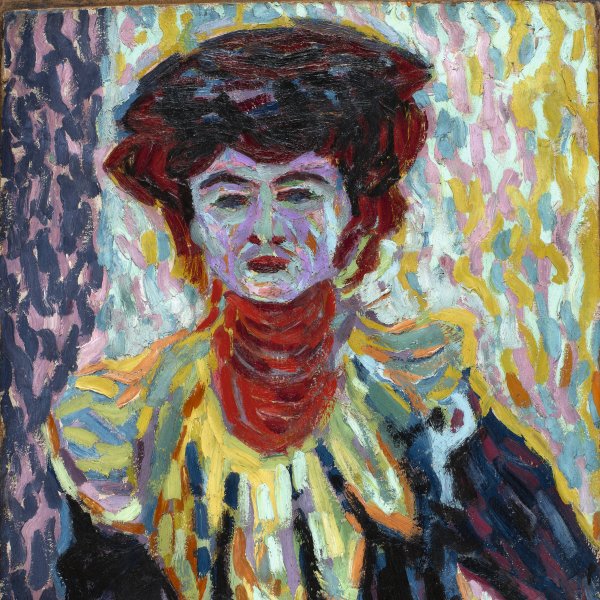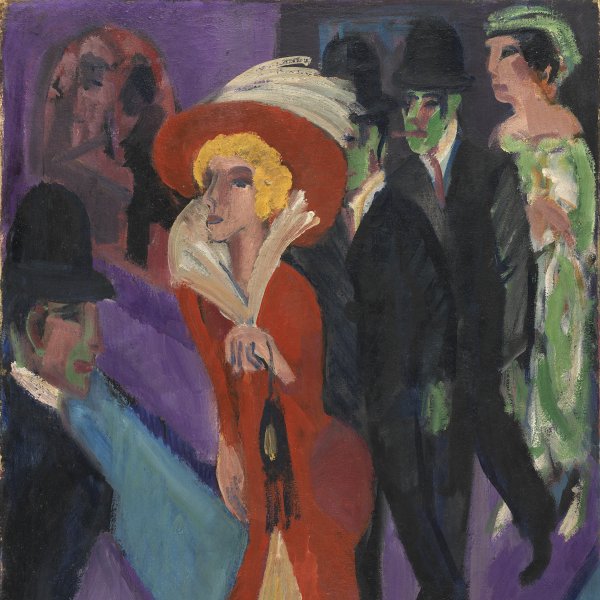Landscape with Chestnut Tree
1913
Oil on canvas.
96 x 85.5 cm
Carmen Thyssen Collection
Inv. no. (
CTB.1996.40
)
ROOM H
Level 0
Carmen Thyssen Collection and Temporary exhibition rooms
Landscape with Chestnut Tree was painted on the German island of Fehmarn in the Baltic in summer 1913. Kirchner's Fehmarn paintings fall into three main categories: beach scenes, often with nude figures; studies of the surrounding landscape, including the farmstead at Staberhof and the nearby Staberhuk beacon (the artist in fact lodged with the lighthouse keeper and his family during several visits to Fehmarn); and depictions of the dense forests and lush vegetation, the profusion of wild flowers and thickets of trees which distinguished his immediate surroundings. Several other paintings done at Fehmarn in 1913 show individual trees, or particular species, for example the picture known as Laburnum Tree now in the collection of Colby College Art Museum, Waterville, Maine.
Landscape with Chestnut Tree is characterised by a nervous intensity in the handling of paint, something new in Kirchner's art. This tendency reaches its climax in his immediately pre-war compositions, including the extended series of Berlin street scenes and depictions of prostitutes which in a sense constitute the urban counterpart to his Fehmarn paintings. While strikingly different in subject, both groups of paintings share a compositional intricacy matched by an ecstatic, visionary quality unparalleled elsewhere in the artist's work, and which he would probably never have achieved without the experience of Fehmarn. Kirchner himself, by his own account, regarded that experience as of particular importance for his own development. Exactly what it meant to him is made clear by the following passage from a letter, which also reveals that his own mental picture of Fehmarn was painted in unmistakably Gauguinesque terms. After the summer he spent there in 1912, he wrote to the jurist Gustav Schiefler, one of the foremost patrons of the Brücke artists' work: "The whole powerful experience of my first sojourn there has now become ever more profound. I have been painting pictures of absolute maturity, so far as I myself can judge. Ochre, blue and green are the colours of Fehmarn, a wonderful coast formation often of South Sea opulence, absurd flowers with fat stems, added to which the indigenous population has pretty much degenerated as a consequence of in-breeding [...]" His admirers also recognised the importance of these works; in another letter of December 1914, Kirchner's friend, the collector Botho Graef, described them as "landscapes which will probably delight even the old academicians, figure paintings most intense in their effects. I asked him for permission to write to you to say how wonderful I find his work.
Seemingly, Landscape with Chestnut Tree had never been exhibited or reproduced before being acquired at auction in the autumn of 1996. The tiny illustration which appears in Gordon's 1968 oeuvre-catalogue of the artist's paintings was evidently reproduced from that contained in the first series of photograph albums preserved in the Kirchner archive.
Peter Vergo
Landscape with Chestnut Tree is characterised by a nervous intensity in the handling of paint, something new in Kirchner's art. This tendency reaches its climax in his immediately pre-war compositions, including the extended series of Berlin street scenes and depictions of prostitutes which in a sense constitute the urban counterpart to his Fehmarn paintings. While strikingly different in subject, both groups of paintings share a compositional intricacy matched by an ecstatic, visionary quality unparalleled elsewhere in the artist's work, and which he would probably never have achieved without the experience of Fehmarn. Kirchner himself, by his own account, regarded that experience as of particular importance for his own development. Exactly what it meant to him is made clear by the following passage from a letter, which also reveals that his own mental picture of Fehmarn was painted in unmistakably Gauguinesque terms. After the summer he spent there in 1912, he wrote to the jurist Gustav Schiefler, one of the foremost patrons of the Brücke artists' work: "The whole powerful experience of my first sojourn there has now become ever more profound. I have been painting pictures of absolute maturity, so far as I myself can judge. Ochre, blue and green are the colours of Fehmarn, a wonderful coast formation often of South Sea opulence, absurd flowers with fat stems, added to which the indigenous population has pretty much degenerated as a consequence of in-breeding [...]" His admirers also recognised the importance of these works; in another letter of December 1914, Kirchner's friend, the collector Botho Graef, described them as "landscapes which will probably delight even the old academicians, figure paintings most intense in their effects. I asked him for permission to write to you to say how wonderful I find his work.
Seemingly, Landscape with Chestnut Tree had never been exhibited or reproduced before being acquired at auction in the autumn of 1996. The tiny illustration which appears in Gordon's 1968 oeuvre-catalogue of the artist's paintings was evidently reproduced from that contained in the first series of photograph albums preserved in the Kirchner archive.
Peter Vergo









